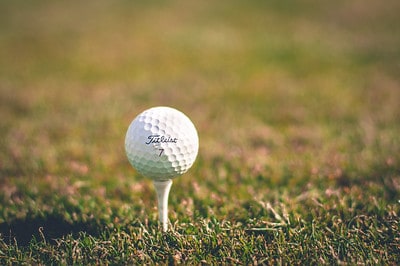How Much Does a Golf Ball Weigh? A helpful overview and 5 fun facts
Unless you are a complete nerd, you may not have wondered how much a golf ball weighs.
The answers may surprise you.
For a newbie, the weight of a golf ball may not even enter consciousness when trying to get an edge on or improve your game. For the low handicapper looking for those 1% micro-improvements, it could be a topic for full deliberation.
How much does a golf ball weigh? Shouldn’t they all weigh the same? Not necessarily. Ball size variations, levels of technology embedded in the ball, the condition of the ball, conditions of the course, and atmospheric conditions can all affect its weight.
Whether you’re a professional golfer or an amateur enthusiast, the weight of a golf ball is an important factor to consider. Understanding the weight of a golf ball can help you make informed decisions regarding your swing, distance, and overall game strategy.

Standard Weight
According to the regulations set forth by the governing bodies of golf, such as the United States Golf Association (USGA) and the Royal and Ancient Golf Club of St Andrews (R&A), the standard weight of a golf ball is 1.620 ounces (45.93 grams). This weight is specified to ensure consistency in the game and to maintain a level playing field for all golfers.
Variations in How Much Does a Golf Ball Weigh
While a standard ball weighs 1.620 ounces, it’s important to note that variations in golf ball weight can occur due to manufacturing processes and design choices made by manufacturers. Golf balls with slight deviations from the standard weight are still considered acceptable for play, as long as they fall within the tolerance guidelines provided by the governing bodies.
It is worth mentioning that some golf balls are intentionally designed to be slightly heavier or lighter than the standard weight. These variations in weight can offer golfers different playing characteristics and performance benefits. For instance, heavier golf balls may provide more distance due to increased momentum, while lighter balls may offer increased control and spin.
Quality Control
To ensure the integrity of the game and fair play, golf ball manufacturers adhere to strict quality control measures. They employ various techniques to ensure that each ball produced meets the predetermined weight specifications. These techniques include weighing individual balls during the manufacturing process, as well as random sampling and testing to verify compliance.

Evolution of Golf Ball Weight
Over the years, the weight of golf balls has evolved along with advancements in technology and changes in player preferences. Early golf balls were made of wood, often filled with feathers, and had significantly different weights compared to modern golf balls. As the sport progressed, golf balls transitioned to lighter materials such as Gutta-percha and eventually to modern synthetic materials like Surlyn and urethane.
The weight of golf balls has also been influenced by advancements in aerodynamics and design. Manufacturers have developed dimple patterns and ball constructions that optimize lift, reduce drag, and enhance overall performance. These advancements have led to consistent golf ball weight and improved distance, control, and feel.
Practical Considerations
Understanding the weight of a golf ball can influence your gameplay and equipment choices. Heavier golf balls may be suitable for players with faster swings, as they can help generate more distance. On the other hand, lighter golf balls may be preferable for players seeking improved control or who have slower swing speeds. It is recommended to experiment with different golf ball weights and evaluate how they impact your game to find the best fit for your individual playing style. Check our guides to help select your ball of choice with our best golf balls of 2023 and best golf balls for beginners and the best golf balls for slower swings.
Conclusion
The weight of a golf ball is an essential characteristic that affects a golfer’s performance on the course. While the standard weight of a golf ball is 1.620 ounces, variations occur due to manufacturing processes and design choices. Golf ball manufacturers maintain strict quality control measures to ensure compliance with regulations set by the governing bodies including the United States Golf Association. Advances in technology and player preferences have led to significant changes in the weight and performance of golf balls over time. By considering the weight of golf balls, players can make informed decisions to optimize their game and achieve their desired results.
Golf Weight Fun Facts
- Historical Weight: The question of how much a golf ball weighs has evolved over time. In the early days of golf, solid wooden balls were used, which were significantly heavier than modern golf balls. These wooden balls could weigh as much as 45 grams (1.6 ounces) or more.
- Minimum Weight Variance: While the Rules of Golf allow for a maximum weight variance of 1.62 grams among golf balls, manufacturers strive for much tighter tolerances. Many modern golf balls have weight variances of less than half a gram, ensuring consistent performance.
- Weight vs. Distance: Increasing the weight of a golf ball does not necessarily result in greater distance. The design and construction of the ball, including factors such as dimple pattern and core materials, play a more significant role in achieving maximum distance.
- Balancing the Ball: Golf ball manufacturers carefully balance the weight distribution within the ball to optimize performance. This balance helps ensure that the ball flies true and maintains stability during its flight. For them, the question of how much does a golf ball weigh is an ongoing obsession.
- Weight and Color: Interestingly, the color of a golf ball can affect its weight. White golf balls are typically slightly lighter than colored balls due to the pigment used in coloring. However, the difference in weight is minimal and unlikely to impact performance significantly.
By delving into these fun facts about the weight of a golf ball, we gain a deeper understanding of the precision and considerations that go into their design, as well as the impact of various factors on their performance and characteristics.

Top Questions
What is a Heavy Ball in Golf?
The Ball of Steel, also known as a heavy ball, is something else! It’s a golf ball that weighs 5 times more than your average ball. What’s really interesting is that it doesn’t have any energy to roll on its own, so you have to create that momentum yourself when you’re putting. What this means is that if you try a decelerating stroke, the ball won’t roll properly. It’s a bit of a trial and error process, but when you mis-hit the ball by hitting it on the toe or heel, or if you hit it too high or low on the face, this heavy ball will let you know right away.
You know what’s the best part? It actually helps you improve your putting technique! I remember when I first tried it, I accidentally double-hit the ball a few times. But thanks to that experience, it taught me to carry my momentum through the ball and focus on hitting a solid putt. When you flip the putter head or don’t put enough force behind it, the ball barely moves. However, once you make a solid stroke using your shoulders, arms, and hands connected, the ball rolls perfectly. The difference is incredible! Then, when you switch back to a standard ball, you instantly feel your new and compact solid stroke.
Oh, and here’s another neat feature: the Ball of Steel has a silicone cover that protects your putter. Now you can focus on nailing that solid hit without worrying about damaging your equipment. The best part about this whole experience is that with a solid stroke, all those other thoughts about distance, target, or method just disappear. You can fully concentrate on hitting the ball well, and that leads to much quicker improvement in your putting game. Trust me, it’s a game-changer!
How does a golf ball’s weight impact distance and trajectory?
A golf ball’s weight can indeed impact its distance and trajectory. Here’s how:
- Distance: The weight of a golf ball plays a role in determining how far it will travel. In general, a heavier golf ball can potentially provide more distance due to its ability to carry more momentum. When struck properly, a heavier ball can generate greater initial velocity and maintain its energy better throughout the flight, leading to increased overall distance. However, it’s essential to consider other factors like ball construction, compression, and aerodynamics, as they also influence distance.
- Trajectory: The weight of a golf ball affects its launch angle and spin, ultimately influencing the trajectory it takes. Lighter golf balls are typically easier to launch higher into the air with less spin, resulting in a higher trajectory. This can be advantageous for golfers seeking more carry distance while sacrificing some roll on the ground. Heavier golf balls, on the other hand, tend to have a lower launch angle and potentially more backspin, leading to a lower trajectory and increased roll upon landing.
It is worth noting that while weight is a factor, golf ball performance is influenced by various other factors, including dimple design, cover material, compression, and swing mechanics. These factors collectively affect how a golf ball interacts with the clubface, air, and turf, ultimately shaping its distance and trajectory characteristics.
What is the standard weight of a golf ball?
The standard weight of a golf ball is typically around 1.62 ounces (45.93 grams) to 1.68 ounces (47.6 grams). Golf balls must meet the weight requirements set by the governing bodies of golf, such as the United States Golf Association (USGA) and the Royal and Ancient Golf Club of St. Andrews (R&A). These organizations have specific regulations to maintain fairness and consistency in the sport.
What are the advantages and disadvantages of using a lighter golf ball?
Using a lighter golf ball can have both advantages and disadvantages. Here are some points to consider:
Advantages of lighter golf balls:
- Increased distance: Lighter golf balls are generally easier to launch higher into the air, which can result in increased carry distance. They require less force to achieve higher ball speeds, especially for golfers with slower swing speeds.
- Improved control for some players: Some golfers may find lighter golf balls easier to control due to their lower spin and higher launch. This can be particularly beneficial for players who struggle with excessive spin or have difficulty getting the ball airborne.
- Reduced strain on the body: Lighter golf balls can potentially cause less strain on the body, especially for players with physical limitations or injuries. The decreased weight may lead to reduced stress on joints, wrists, and elbows during the swing.
Disadvantages of lighter golf balls:
- Reduced accuracy in windy conditions: Lighter golf balls are more susceptible to the effects of wind due to their lower mass. They may get pushed around more by crosswinds, making it challenging to control distance and accuracy accurately.
- Limited control and feel around the greens: Lighter golf balls may lack the necessary control and feel required for delicate shots around the greens. They might not provide enough spin or responsiveness, making it difficult to execute precise shots like chips, pitches, and greenside bunker shots.
- Less overall consistency: Some golfers may find that lighter golf balls have less overall consistency compared to heavier ones. The decreased weight can make it more challenging to achieve consistent impact and control, especially for players who prefer a certain level of feedback and feedback from the ball.
Ultimately, the choice between using a lighter or heavier golf ball depends on individual preferences, swing characteristics, and playing conditions. It is recommended to experiment with different types and weights of golf balls to find the one that suits your game best.
Does the weight of a golf ball affect accuracy?
The weight of a golf ball can have an impact on accuracy, although it is just one of several factors influencing shot precision. Here’s how the weight of a golf ball can potentially affect accuracy:
- Shot consistency: The weight of a golf ball can influence how consistently it performs in terms of flight and distance. Heavier balls might require more precise contact and may be less forgiving on off-center hits, potentially leading to less accuracy. Conversely, lighter balls could offer a bit more forgiveness on mis-hits due to their higher launch and potentially reduced sidespin.
- Wind susceptibility: A golf ball’s weight affects its response to wind conditions. Lighter balls can be more affected by crosswinds due to their reduced mass, potentially leading to less accurate shots when faced with challenging wind conditions.
- Feel and control: Golfers often rely on the feel and feedback from a golf ball to control their shots accurately. Some players prefer the sense of control provided by heavier balls, as they can perceive more feedback during impact. This feedback can contribute to improved accuracy in shot-shaping, distance control, and wedge play around the greens.
- Player preference: Accuracy is subjective and can vary depending on individual preference. Some golfers may find that they have better accuracy using a specific weight of a golf ball that suits their swing characteristics and playing style.
It’s important to note that accuracy in golf depends on various factors, including technique, equipment, swing consistency, and course conditions. While the weight of a golf ball can have some influence on accuracy, it is just one aspect to consider, along with other factors like ball construction, compression, and overall design.
How does the weight of a golf ball impact the feel and feedback during impact?
The weight of a golf ball can impact the feel and feedback experienced by a golfer during impact. Here’s how:
- Sensory feedback: Heavier golf balls may provide a golfer with a greater sense of feedback during impact. The additional mass can create a more noticeable sensation and vibration, which some golfers prefer as it provides them with a better perception of the shot quality and connection with the ball.
- Sound: The weight of a golf ball can also influence the sound produced upon impact. Heavier balls tend to generate a lower-pitched sound, which some golfers find pleasing and more indicative of a solid strike. This auditory feedback can contribute to the overall feel and perception of the shot.
- Perception of control: The weight of a golf ball can influence a golfer’s perception of control. Some players may feel more in control and confident with a heavier ball, as the additional weight gives them a sense of stability and solidity during impact.
- Personal preference: The feel and feedback experienced during impact can vary greatly from golfer to golfer. What feels good and provides the desired feedback can be subjective and dependent on individual preference. Some golfers prefer the softer feel and minimal feedback of lighter balls, while others may prefer the firmer feel and heightened feedback from heavier balls.
It’s important to note that while the weight of a golf ball can contribute to feel and feedback, there are other factors at play as well, such as ball construction, cover material, compression, and overall design. Every golfer has different preferences and perceptions, so experimenting with different weights and types of golf balls is recommended to find the one that offers the desired feel and feedback for individual play.







